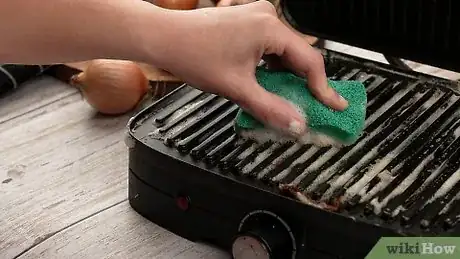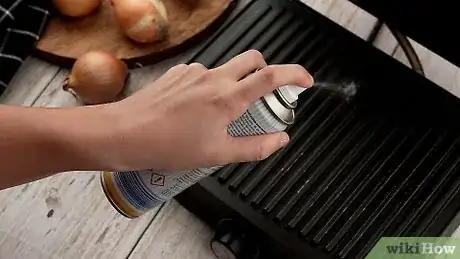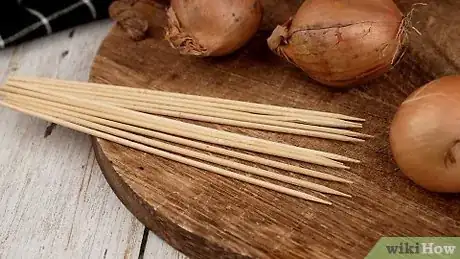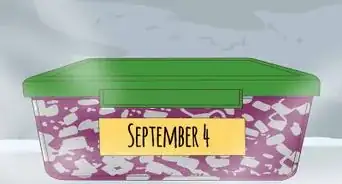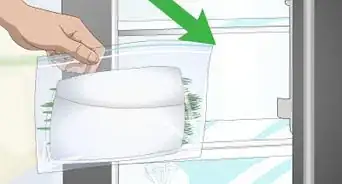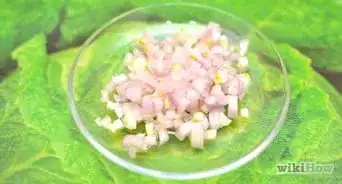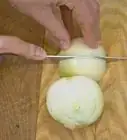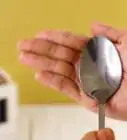This article was co-authored by wikiHow Staff. Our trained team of editors and researchers validate articles for accuracy and comprehensiveness. wikiHow's Content Management Team carefully monitors the work from our editorial staff to ensure that each article is backed by trusted research and meets our high quality standards.
The wikiHow Culinary Team also followed the article's instructions and verified that they work.
This article has been viewed 121,752 times.
Learn more...
Adding onions to your next grilling adventure will not only add a burst of sweet flavor but can also provide you with some terrific health benefits. Regularly eating onions has been linked to preventing cancer and improving bronchitis.[1] Learning how to grill onions to accompany your favorite meal can enhance the meal's flavors and improve your health.
Steps
Prepping Your Grill and Ingredients
-
1Clean your grill before using. Especially if you're going to put your onions directly on your grill, you need it to be clean. Even if you're not, a clean grill cooks better than a dirty one.
- To clean your grill, put some vegetable oil on a paper towel, and wipe each rod down, one by one. You can also put the oil directly onto the grill and scrape off the grime with a grill spatula or other tool if necessary.
- Some grills have a "cleaning" setting. If the above isn't enough, you may wish to use this option if you have it.
-
2Once clean, spray with oil to prevent sticking. Oil not only cleans your grills, but prevents food from sticking to it. Be sure to this before you turn the heat on, otherwise it will cook away.
- Any kind of oil is fine. This is not the oil that will be going on your onions, so a cheap vegetable oil will be perfect for the job.
Advertisement -
3Choose between tin foil, baskets, trays, or skewers. Barring circular slices of onion, it's easiest to grill onions with some sort of device to make sure all sides get cooked and that they don't fall through the grates. A tin foil tent, basket, tray, or skewer inserted through the onion will all work well.
- You could also just use a piece of tin foil over the grate, with holes poked through it to let out heat.
- If you do use skewers, make sure they're soaked in water first so they don't catch on fire.
-
4If you don't have any equipment, stick to large slices or whole onions. If you have none of the above items on hand, you'll need to stick to large slices or whole onions. Large, circular slices are going to be easiest as it's difficult to grill a whole onion evenly – inevitably one side gets more cooked than the others.
-
5Choose how you're going to coat your onions. Olive oil, salt and pepper, and your favorite seasoning blend are staples of grilled onions. Some people also like to use butter and beef bouillon granules, too. Here are some other ideas you could use, regardless of the shape of your onion:
- Honey mustard
- Balsamic vinegar
- BBQ sauce
- Worcestershire sauce
- Steak seasoning
Grilling Onion Slices or Wedges
-
1Select large, firm onions from your local produce supplier. Vidalia onions are a popular choice based upon their size and flavor. Sweet onions are the most popular, and red sweet onions are very common, too.
- Any onion, so long as it's large and fresh, will do the trick. In the case of whole onions, symmetrical is best, so one side doesn't naturally rest on its bottom, getting cooked unevenly.
-
2Slice off the stem end of the onion and peel. Remove any of the loose, dry outer skin that is thin like paper and is peeling. Inspect the next layer of the onion for any shriveling or damage, and remove if necessary. You should be able to tell when you hit the meat of the layers.
-
3Cut the onion. To make slices, hold the onion at the root end, and place it sideways on the cutting board. Your hand and the root should be horizontal to the board. Cut the onion into thick slices, generally half an inch thick (1.3 cm).
- To cut into wedges, don't cut all the way to the bottom of the onion. If you do, they'll fall apart. Wedges should be about 1 inch (2.5 cm) wide, and a good-sized onion will yield 4-6 wedges.[2]
- These are just recommendations. You can cut the onion however you like, from thick wedges to whole slices. Just know that the smaller your onions are, the more likely they'll be to fall through the grate – for small onions, you'll need equipment to keep that from happening.
-
4Brush the slices with olive oil and flavor to taste. Add any seasonings you like, such as salt, pepper, or garlic powder, too. A list of possibilities is discussed above, but olive oil, salt, and pepper is a general standard. Make sure you get both sides!
-
5Preheat your grill to medium heat. Place the onion slices directly onto the grill surface. Alternatively, use your grill basket or a tent made out of aluminum foil. Allow them to cook for approximately 3-5 minutes or until you can see black grill marks. Larger, thicker onions may take up to 7.[3]
- To make a foil tent, simply place a couple of onion slices on a piece of foil. Turn the long sides in, covering the onions, and then roll up the sides, enclosing them in.
- Skewers are easiest for wedges, if you're worried about them falling apart. Again, just make sure they were soaked in water before use, or they may start a fire.
-
6Turn the grilled onion slices over with your tongs. Allow the other side to cook for another 3-5 minutes or until you see grill marks. If you want to re-season or add more olive oil, do so now.
- Give the edge of one a taste test. Does it have a hint of a crunch initially, but is still soft and getting caramelized? That's exactly when you know they're done.
-
7Remove the onion slices from the grill, and serve with your meal. Grilled onions make their own delicious side dish, but they're also great added to salsa, relish, baked beans, curries, and any other vegetable dish.
Grilling Whole Onions
-
1Remove any of the loose, dry outer skin on the onion. Inspect the next layer of the onion for any shriveling or damage, and remove if necessary. If it doesn't look like you want to eat it, keep peeling.
- Keep the bottom side – the part with the roots or the hair – intact. It's the base of your onion.
-
2Cut the onion. Start by cutting off the top 1/3 of the onion and discard. Then, you need to core the onion. To do this, insert your knife into the edge of the core, stopping before you hit the bottom (or it won't be a whole onion anymore). Do this around the core until you can pry it out, leaving the bottom intact.
- Slice from the hole you just made into the layers, stopping before you hit the outside of the onion (again, you want a whole onion, not wedges). This allows your seasonings to soak through each layer.[4]
- Alternatively, you can use your knife tip, and puncture small holes around the middle section of the onion. Instead of in the core, these holes are where you would put the seasoning.
-
3Season the onion as you like. Most people start off with butter or olive oil for their base. Then you can add any flavors you like, such as salt, pepper, or garlic powder. A short list is discussed in the first section, though whatever speaks to you is best!
- Use a combination of herbs and spices, or a pre-prepared seasoning (like a steak seasoning) to get a full-bodied taste that complements the natural taste of the onion. Keep in the mind the dish it's being paired with (if that's the case) when you're debating between a sweet or savory touch.
-
4Wrap the whole onion in a tin foil pouch, and seal any openings. Place the onion pouch onto the grill surface on medium to medium-high heat, and allow it to cook for approximately 20 to 30 minutes. Check it only periodically to keep the heat sealed into the pouches.
- Some onions (and some grills) can take up to 45 minutes. If your onion is taking longer than 20 to 30 minutes, don't fret. This is normally, especially for larger onions. If in doubt, give it a little longer – if it's not quite done, the insides may only be warm.
-
5Remove from the grill, and serve with your meal. Grilled whole onions are almost a meal in themselves – a small salad and a slice of fresh bread and you're set. But they're also great in stews, curries, or with any other hot vegetable dish.
Community Q&A
-
QuestionHow long can I leave a raw onion wrapped up in tin foil?
 QamarTop AnswererThe raw onion can last about 7-10 days if it's stored in the fridge.
QamarTop AnswererThe raw onion can last about 7-10 days if it's stored in the fridge.
Warnings
- When slicing grilled onions, be sure to keep the hand holding the onion on the cutting board dry to prevent the onion from slipping. For additional protection, keep your fingers bent or tucked under, and away from the knife's blade.⧼thumbs_response⧽
Things You'll Need
- Onion
- Cutting board
- Grill
- Knife
- Olive oil or butter, seasonings
- Tongs
- Tin foil (recommended)
References
- ↑ http://www.webmd.com/cancer/news/20061121/cancer-prevention-helped-by-onions-and-garlic
- ↑ http://onions-usa.org/media/view/3/Ten-Tips-for-Perfectly-Grilled-Onions
- ↑ http://www.foodnetwork.com/recipes/rachael-ray/grilled-red-onions-recipe.html
- ↑ http://www.grillingcompanion.com/grilled-whole-onion/#
- http://www.recipetips.com/kitchen-tips/t--1418/grilling-onions.asp
- http://www.vegetarian-nutrition.info/updates/onions.php
